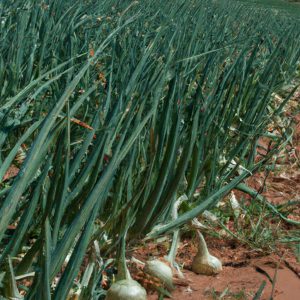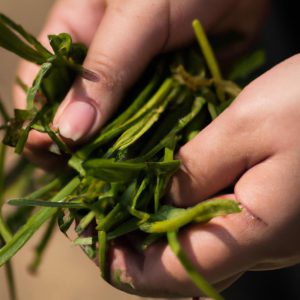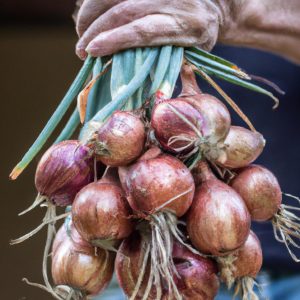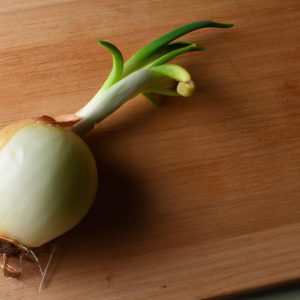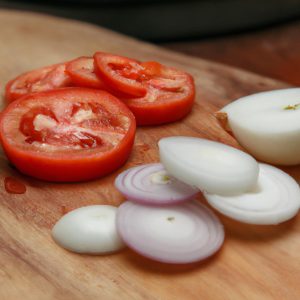If you’re a fan of savory dishes, you’ve probably come across recipes that call for caramelized onions and peppers. Caramelization is a cooking technique that involves browning the natural sugars in onions and peppers, resulting in a sweet, rich flavor and a soft, tender texture. In this article, we’ll explore how to caramelize onions and peppers to perfection, from preparing the vegetables to selecting the right cooking method.
A. Definition of Caramelization

Caramelization is a chemical reaction that occurs when sugars are heated to high temperatures, causing them to break down and form new compounds. In the case of onions and peppers, the natural sugars in the vegetables are released and begin to brown and caramelize, resulting in a deeper, more complex flavor. This process is often used in cooking to enhance the taste and texture of dishes, especially in French cuisine.
B. Benefits of Caramelized Onions and Peppers

Caramelized onions and peppers add a unique and delicious flavor to a wide range of dishes, from sandwiches and burgers to soups and stews. They also offer a variety of health benefits, including high levels of vitamins and minerals, such as Vitamin C and potassium. Additionally, caramelized onions and peppers are low in calories and fat, making them a healthy addition to any meal.
C. Overview of the Article

In this article, we’ll cover everything you need to know about caramelizing onions and peppers, including the science behind caramelization, the best types of onions and peppers to use, and the different methods for caramelizing them. We’ll also provide tips for ensuring that your onions and peppers caramelize perfectly every time and offer recipe ideas for incorporating caramelized onions and peppers into your favorite dishes. So, let’s get started!
The Basics of Caramelization
Caramelization is a fundamental cooking technique that can elevate the taste of any dish. To achieve the perfect caramelization, it’s essential to understand the science behind the process and the factors that affect it. In this section, we’ll explore the basics of caramelization and provide tips for successful caramelization.
A. Science behind Caramelization
Caramelization is a complex chemical reaction that occurs when the natural sugars in onions and peppers are heated to high temperatures. As the temperature rises, the sugar molecules break down and form new compounds, resulting in the characteristic brown color and rich flavor. This process is known as the Maillard reaction, which is responsible for the browning of many foods, including bread, meat, and vegetables.
B. Factors Affecting Caramelization
Several factors can affect the caramelization process, including the type and age of the onions and peppers, the size and shape of the pieces, and the heat source. For example, sweeter onions and peppers tend to caramelize more quickly than less sweet varieties. Additionally, smaller and thinner pieces of onions and peppers will caramelize faster than larger and thicker pieces. Heat source is also crucial, as high heat is necessary to initiate caramelization.
C. Tips for Successful Caramelization
To achieve perfect caramelization, it’s essential to follow a few tips. First, choose the right type of onions and peppers, such as sweet onions and red peppers, which have a higher sugar content. Second, cut the onions and peppers into uniform pieces to ensure even cooking. Finally, use high heat and avoid stirring the onions and peppers too often, as this can slow down the caramelization process. With these tips, you’ll be able to achieve perfectly caramelized onions and peppers every time.
Preparing Onions and Peppers for Caramelization
To achieve the perfect caramelization, it’s essential to prepare your onions and peppers properly. Here are some tips to ensure that your vegetables are ready for the caramelization process:
A. Choosing the Right Onions and Peppers
Not all onions and peppers are created equal when it comes to caramelization. For onions, the best types to use are yellow onions, red onions, or sweet onions. These onions have a higher sugar content, making them ideal for caramelization. As for peppers, you can use any color you prefer, but red and yellow peppers tend to caramelize more evenly than green peppers.
B. Cleaning and Cutting Techniques
Before caramelizing your onions and peppers, it’s essential to clean and cut them properly. Start by peeling and slicing your onions thinly, as this will help them caramelize more evenly. For peppers, remove the stem and seeds, and slice them into thin strips or small cubes. It’s important to make sure that your vegetables are cut to the same size to ensure even caramelization.
C. Flavor Additions
While caramelized onions and peppers are delicious on their own, you can add extra flavor to them by incorporating herbs, spices, and other ingredients. For example, you can add garlic, thyme, or rosemary to your onions while they caramelize, or you can sprinkle cumin or paprika over your peppers. You can also add a splash of balsamic vinegar or wine to enhance the flavor profile. Just be careful not to add too much liquid, as this can prevent the caramelization process from occurring.
Techniques for Caramelizing Onions and Peppers
Caramelizing onions and peppers can be done using a variety of techniques, each with its own advantages and disadvantages. Here are three popular methods for caramelizing onions and peppers:
A. Stovetop Method
The stovetop method is one of the most common ways to caramelize onions and peppers. To use this method, heat a large skillet over medium heat and add a tablespoon of oil or butter. Once the oil is hot, add the onions and peppers and stir them occasionally for 30-40 minutes, or until they are golden brown and caramelized. Be sure to keep an eye on the vegetables while they cook to prevent them from burning.
B. Oven Method
The oven method is another great way to caramelize onions and peppers. To use this method, preheat your oven to 400°F and line a baking sheet with parchment paper. Slice the onions and peppers into thin strips and place them on the baking sheet. Drizzle the vegetables with olive oil and sprinkle them with salt and pepper. Roast the vegetables in the oven for 30-40 minutes, or until they are caramelized to your liking. You can also add other seasonings, such as garlic or rosemary, to give the vegetables added flavor.
C. Slow Cooker Method
The slow cooker method is the easiest and most hands-off way to caramelize onions and peppers. To use this method, simply slice the onions and peppers into thin strips and place them in a slow cooker. Add a tablespoon of oil or butter and stir the vegetables to coat them. Cook the vegetables on low for 6-8 hours, or until they are caramelized and tender. This method is perfect for busy weeknights or when you want to set it and forget it.
No matter which method you choose, the key to perfect caramelization is patience and attention to detail. With a little practice, you’ll be able to master the art of caramelizing onions and peppers and take your cooking to the next level.
Serving Suggestions and Recipe Ideas
Once you’ve mastered the art of caramelizing onions and peppers, there are countless ways to incorporate them into your favorite dishes. Here are some serving suggestions and recipe ideas to help you get started:
A. How to Use Caramelized Onions and Peppers
Caramelized onions and peppers can be used in a variety of ways, from topping pizzas and burgers to adding flavor to soups and stews. Here are some ideas to inspire you:
- Spread caramelized onions and peppers on a toasted baguette with melted cheese for a delicious appetizer.
- Add caramelized onions and peppers to scrambled eggs or omelets for a savory breakfast.
- Use caramelized onions and peppers as a topping for pizzas, burgers, or hot dogs.
- Mix caramelized onions and peppers into your favorite pasta dish for a burst of flavor.
- Incorporate caramelized onions and peppers into your favorite soup or stew recipe for added depth and complexity.
B. Recipe Ideas with Caramelized Onions and Peppers
If you’re looking for specific recipe ideas, here are some dishes that use caramelized onions and peppers as a key ingredient:
- Caramelized Onion and Pepper Quiche: This savory quiche features a buttery crust filled with caramelized onions, peppers, and cheese.
- Caramelized Onion and Pepper Fajitas: These fajitas are packed with flavor, thanks to the combination of tender, caramelized onions and peppers and your favorite protein.
- Caramelized Onion and Pepper Pizza: Top your favorite pizza crust with caramelized onions, peppers, and your favorite cheese for a delicious and unique pizza.
- Caramelized Onion and Pepper Dip: This creamy dip features caramelized onions and peppers blended with cream cheese and sour cream for a delicious appetizer.
- Caramelized Onion and Pepper Grilled Cheese: Take your grilled cheese to the next level by adding caramelized onions and peppers to the sandwich.
C. Pairing Suggestions
Caramelized onions and peppers pair well with a variety of different flavors and ingredients. Here are some pairing suggestions to help you create the perfect dish:
- Pair caramelized onions and peppers with grilled meats, such as steak or chicken.
- Serve caramelized onions and peppers alongside roasted vegetables, such as carrots or brussels sprouts.
- Use caramelized onions and peppers as a topping for baked potatoes or sweet potatoes.
- Pair caramelized onions and peppers with creamy cheeses, such as brie or goat cheese.
- Serve caramelized onions and peppers alongside a salad for added flavor and texture.
With these serving suggestions and recipe ideas, you’ll be able to incorporate caramelized onions and peppers into a variety of dishes and elevate your cooking to the next level.
Conclusion
In conclusion, caramelized onions and peppers are a delicious and healthy addition to many different dishes. By following the tips and techniques outlined in this article, you can achieve perfectly caramelized vegetables every time. Remember to choose the right type of onions and peppers, prepare them properly, and use the right cooking method to achieve the desired level of caramelization.
Not only do caramelized onions and peppers add a rich flavor to your meals, but they also offer a variety of health benefits. They are low in calories and fat, and high in vitamins and minerals, making them a nutritious addition to any diet.
So, whether you’re looking to add some depth and complexity to your favorite recipes or simply want to try something new in the kitchen, caramelizing onions and peppers is a technique that’s sure to impress. Don’t be afraid to experiment with different flavors and cooking methods to find the perfect combination for your taste buds.
And there you have it, a complete guide to caramelizing onions and peppers. We hope this article has been informative and helpful in your culinary endeavors. For more onion-related tips, tricks, and recipes, be sure to visit onionfacts.com.

